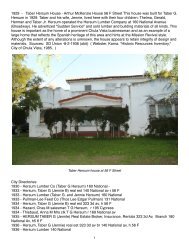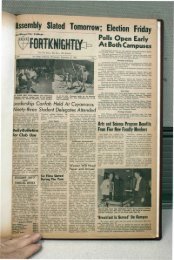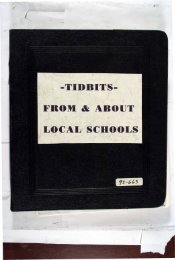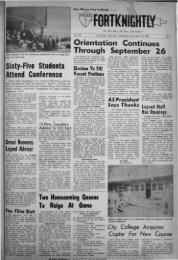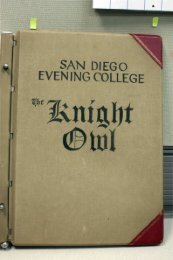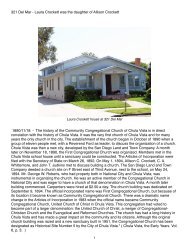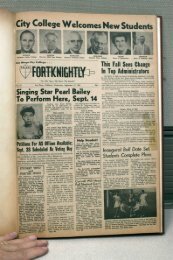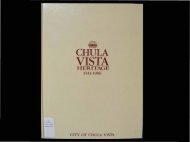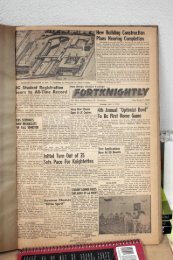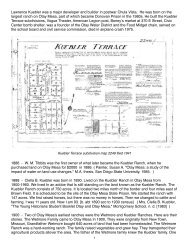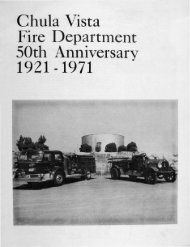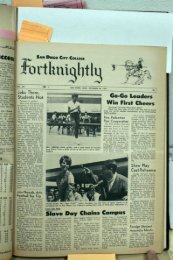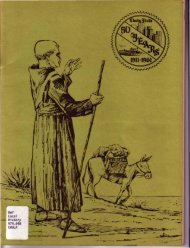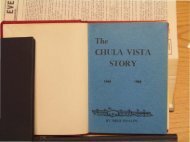doc241 - Schoenherr Home Page in Sunny Chula Vista
doc241 - Schoenherr Home Page in Sunny Chula Vista
doc241 - Schoenherr Home Page in Sunny Chula Vista
Create successful ePaper yourself
Turn your PDF publications into a flip-book with our unique Google optimized e-Paper software.
1834, Roxana.<br />
1835, Pilgrim.<br />
1836, Lagoda, Loriotte, Catal<strong>in</strong>a.<br />
1836-7, Kent.<br />
1837, Rasselas, Sophia.<br />
1839, Morse.<br />
1840, Alciope.<br />
1840-1, Monsoon.<br />
1841, Thomas Perk<strong>in</strong>s.<br />
1841-2-3-5-7, Tasso.<br />
1842-4-6-7, Barnstable.<br />
1839-43-4, Fama.<br />
1844, Menkar.<br />
1844-5, Sterl<strong>in</strong>g.<br />
1845, Martha, Admittance.<br />
1846, Vandalia.<br />
1847-8, Olga.<br />
The hide and tallow trade practically ended with the transfer of California to the<br />
United States. This was a mere co<strong>in</strong>cidence, due to economic rather than to political<br />
causes. New England found that she could get her hides cheaper somewhere else. The<br />
trade had marked the high tide of prosperity <strong>in</strong> old California days, and supplied an <strong>in</strong>terest<strong>in</strong>g<br />
and romantic episode <strong>in</strong> the history of the country. Excellent accounts of this<br />
period may be found <strong>in</strong> the writ<strong>in</strong>gs of Bancroft, Dana, Rob<strong>in</strong>son, and Davis. The latter,<br />
perhaps the most competent authority, estimates the total number of hides exported<br />
from California at about 5,000,000 and the tallow at 250,000,000 pounds.<br />
Even after the cattle bus<strong>in</strong>ess passed mostly <strong>in</strong>to private hands, the missions<br />
profited largely from it, by means of tithes, a form of ecclesiastical tax scrupulously paid<br />
by the rancheros and diligently collected by the missionaries. This tax was collected, <strong>in</strong><br />
some <strong>in</strong>stances, as late as 1850 or 1851. The missions were also the pr<strong>in</strong>cipal customers<br />
of the American ships. Their cargoes consisted of sugar, tea, coffee, rum, silk, furniture,<br />
calico, cloth<strong>in</strong>g, and blankets for the Indians, which they sold to the friars for cash<br />
and exchanged for hides. William A. Gale, Alfred Rob<strong>in</strong>son, and William Heath Davis did<br />
a large bus<strong>in</strong>ess with the missions for many years.<br />
In Rob<strong>in</strong>son's Life <strong>in</strong> California is an <strong>in</strong>terest<strong>in</strong>g account of the pa<strong>in</strong>s which were<br />
taken, upon his first visit to San Diego,<br />
<strong>Page</strong> 105<br />
<strong>in</strong> 1829, to enterta<strong>in</strong> the good Father Antonio Peyri, founder of the San Luis Rey Mission,<br />
and especially to impress him with the excellence of the stores brought <strong>in</strong> the<br />
Brookl<strong>in</strong>e, from Boston. This enterta<strong>in</strong>ment seems to have proven quite profitable, <strong>in</strong><br />
the end. The missionaries kept the first, and for many years the only, stores, from which<br />
they supplied the wants of their neophytes and sold goods to such as desired them.<br />
Their success soon stimulated emulation <strong>in</strong> this, as <strong>in</strong> other, l<strong>in</strong>es and private fortunes<br />
began to grow. The first storekeeper at San Diego, and the only one for some years,<br />
was Capta<strong>in</strong> Henry D. Fitch, who dealt <strong>in</strong> furs, hides, and general merchandise. After<br />
the cattle bus<strong>in</strong>ess began to assume importance and private residences were estab-



